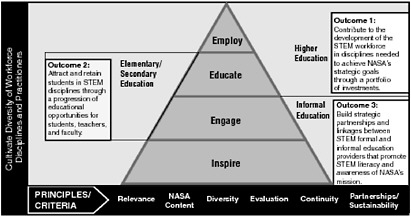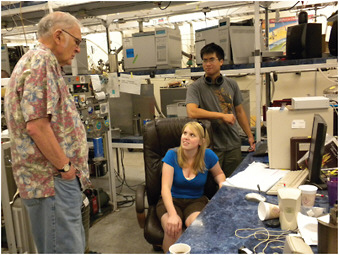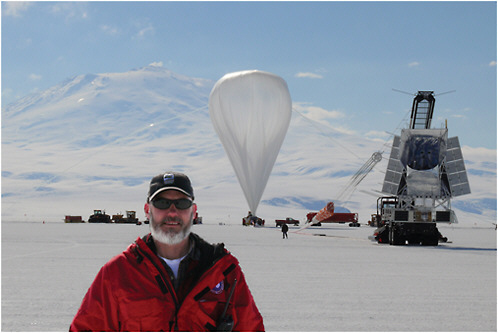6
Progressing from Education to Training to Workforce Development
6.1
INTRODUCTION
Numerous studies of U.S. education, including the report Rising Above the Gathering Storm: Energizing and Employing America for a Brighter Economic Future (NAS-NAE-IOM, 2007), have pointed out the threat to the nation’s economic standing and even security if we fail to produce and maintain a technologically competent workforce. NASA clearly shares this concern. It is addressed in detail in the recent NRC report Building a Better NASA Workforce: Meeting the Workforce Needs for the National Vision for Space Exploration (NRC, 2007). Suborbital projects offer a particularly productive means of providing hands-on training to the next-generation workforce for the nation’s space program needs.
|
In general, students with hands-on experience—ones that suffer through the pain of designing something, struggling to make/fabricate/build [a] system, figure how to … test [it], fly [it] and even enjoy the possibility of a failure (and if it fails, the drive to find the why)—are worth their weight in gold. —Gopal Vasudevan, Senior Staff Scientist, Lockheed Martin ATC |
6.2
CONTEXT
NASA education and public outreach efforts are broad in scope, ranging from efforts to inspire public interest in science (such as by the Hubble legacy images) to formal education to the training of the agency’s own scientists and engineers, as symbolized in Figure 6.1. Suborbital programs contribute at all these levels, as discussed below, but they are particularly effective in the advanced training of scientists, engineers, project managers and systems engineers—a valuable contribution whether these men and women work for NASA, industry, or academe.
SOFIA (see Chapter 5) has a substantial education and public outreach (EPO) component, centered on including K-12 teachers and other educators as members of the flight teams on SOFIA science missions. This is intended to have a multiplier effect as these teachers carry both what they have learned and the excitement of doing airborne

FIGURE 6.1 NASA education strategic coordination framework pyramid showing outcomes mapped to the education strategic framework. The contribution of the suborbital elements is largest at the top of the pyramid. SOURCE: NASA, NASA Education Strategic Coordination Framework: A Portfolio Approach, Washington, D.C., 2006; available at http://education.nasa.gov/pdf/151156main_NASA_Booklet_final_3.pdf
infrared astronomy back to their classrooms. SOFIA team members are also contributing to informal education through the production of planetarium shows.
As an example of the contributions of suborbital projects to formal education, nearer the peak of the EPO pyramid, the rocket program (see Chapter 4) supports several hands-on programs for high school and college students, designed to provide exposure to the basics of rocketry and even, in some cases, flight opportunities (for example, the RockOn! workshops; see Section 4.3). The Student Airborne Research Program (SARP) described in Chapter 2 has similar aims in Earth and atmospheric science that can be accomplished using aircraft (see Figure 6.2). The inclusion of small, student-designed payloads on commercial suborbital flights would offer another way to introduce undergraduates and graduate students to the excitement of research in microgravity or other aspects of life and physical science (see Section 4.3).
In addition, suborbital projects frequently involve undergraduates in all phases of projects, from planning to construction to testing and finally to data analysis. The Balloon-borne Large Aperture Submillimeter Telescope (BLAST) balloon program described in Chapter 3 is one example—undergraduates were involved in this large-scale mission from the outset (Figure 6.3).
It is, however, in the training of a technologically savvy workforce that NASA’s suborbital programs have played a vital and disproportionate role. While the funding of the suborbital elements is a small fraction (<1 percent) of NASA’s SMD budget, many of the scientists and engineers now leading or planning NASA mission areas are veterans of suborbital flights. Suborbital programs thus benefit both NASA and the nation not only by producing first-rate science, but also by turning out experienced scientists and engineers. If the suborbital programs weaken, this supply of experienced staff will wither.
There are several reasons why suborbital programs have had a disproportionate weight as incubators of such talent. First, the scale of suborbital projects, unlike the larger scope of satellite missions, is appropriate for training students, postdocs, and even faculty members in a wide variety of science and engineering fields that are essential to a well-prepared technological workforce. This training includes management skills such as careful budgeting, prioritization, delegation of responsibility and clear communication skills. Suborbital projects are small enough to allow/require the exercise of a wide variety of engineering and management skills by many members of the project team, whereas larger space missions tend to foster the development of more specialized and narrowly focused

FIGURE 6.2 Nobel Laureate F. Sherwood Rowland sharing research opportunities with two undergraduate participants in a SARP project. SOURCE: National Suborbital Education and Research Center, University of North Dakota.

FIGURE 6.3 Mark Devlin shown just before the launch of the Balloon-borne Large Aperture Submillimeter Telescope (BLAST). SOURCE: Courtesy of Mark Devlin, University of Pennsylvania, and Mark Halpern, University of British Columbia.
skills. On the other hand, suborbital projects are also of large enough scope to allow/require training in project management and systems engineering.
It goes without saying that the smaller scale of suborbital experiments permits riskier—and potentially more innovative or rewarding—projects than would be easy to justify on a larger space mission. This opens up greater scope to the training opportunities such experiments can provide.
In addition to the scale of such projects, the duration of most suborbital projects is consistent with the 3 to 6 years expected to complete graduate studies, and roughly consistent with a typical postdoctoral appointment. Thus, students and postdocs, as well as faculty and engineering staff, can experience all phases of an experiment, from planning, to construction, to flight and data analysis. A shorter time scale also increases flexibility.
It is the hands-on experience of designing, building, testing, and flying a project that is most valuable. It is no surprise that many PIs and project scientists involved with ongoing satellite missions got their start in suborbital projects. To cite examples from just one key area of research, work on the cosmic microwave background (CMB), both the PIs of ESA’s Planck mission, and both leads of the U.S. Planck Team were involved in suborbital balloon projects. John Mather and George Smoot, 2006 Nobel Laureates in Physics, made early CMB measurements from balloons and aircraft before joining the COBE mission (Mather is now the senior project scientist on the James Webb Space Telescope). Looking to the future, many of the planned CMB experiments mentioned in Chapter 3 above are led by scientists trained in suborbital flights, and will employ technology tested out in suborbital flights. The same is true in many other fields of astronomy and Earth science. The PIs of NuSTAR, Swift, and all of the instruments flown on the Compton Gamma-ray Observatory had experience in suborbital missions before moving on to larger-scale satellite missions. So too did Tom Prince, mission scientist for LISA and former chief scientist at the Jet Propulsion Laboratory (see text box below).
Finding: Suborbital projects have contributed substantially and disproportionately to the training of NASA’s technical workforce and more broadly to the nation’s pool of experienced scientists and engineers.
|
I have been working on suborbital balloon payloads since graduate school in the early 1990s. Over the course of the last 20 years or so, I have worked with some of the most talented and diverse scientists I could possibly imagine. Along the way everyone (students, postdocs, and faculty) developed a diverse set of skills that has uniquely prepared us to approach new and ever more challenging projects. My students and my collaborators have gone on to wonderful jobs with a diversity equal to the skills they have acquired. Some are in the aerospace industry, some work at government labs, and others have remained in academia. The last student I sent to Lincoln labs resulted in a request, “Do you have any more?!?” In the end we have produced some great science, some great students, and some great technology. What more could you ask for? —Mark Devlin, Principal Investigator of the BLAST project |
|
The NASA Balloon Program was critical to my development as a scientist, both in graduate school and as a junior faculty member at Caltech. I can’t imagine a better scientific training for experimental space science than the experience of building and launching a science payload on a balloon. You directly experience all the important steps: design to cost, schedule, weight, and power constraints; quality control and risk management; field operations; and reduction and analysis of data. The impact of the NASA Balloon Program goes far beyond the demonstration of technology and the direct science data that are produced. The scientists who “cut their teeth” in the NASA Balloon Program are very often the leaders of today’s NASA space science missions and programs. —Thomas Prince, Caltech Professor of Physics, JPL Chief Scientist, and LISA Mission Scientist |
|
R. Gilbert (Gil) Moore got started on his 62-year (and still counting) space career when he was a second-semester engineering student at the New Mexico College of Agriculture and Mechanic Arts (now New Mexico State University). He was hired in April 1947 as a part-time employee of the college’s Physical Science Laboratory to process film recordings of telemetry transmissions and to reduce telemetry data from launches of captured German V-2 rockets at the nearby White Sands Proving Ground (now the White Sands Missile Range). It is profoundly hoped that NASA will enhance its long-standing suborbital programs, of which it has been justifiably proud, and will also once again resume the orbital student experiment opportunities that it used to sponsor but terminated in recent years. The saddest words ever spoken by a NASA administrator were these, in response to a question from a college student at a small satellite conference a few years ago: “Frankly, flying student experiments in orbit is a luxury that we cannot afford at the present time.” The new mantra should instead be: “Providing suborbital and orbital flight opportunities for student experiments is a logical and affordable way of insuring continuity of our Nation’s proud heritage in space.” —R. Gilbert Moore, Director, Project Starshine |
6.3
NEEDS
Balloon flights, because of the complexity of most of their payloads and the need to manage all aspects of a flight from detector arrays to optics, tracking systems, and often cryogenic systems, generally offer rich training opportunities. In the case of rocket and airborne experiments, fractions of the engineering aspects are now managed by contractors under the government-owned, contractor-operated model. This reduces the training opportunities for engineers as contrasted to the scientists using these facilities. The committee is concerned about this erosion of training opportunities for engineers in both the NASA workforce and at universities. In addition, many of NASA’s admirable educational programs listed above focus more on science than engineering.
Finding: The opportunities for training and education offered by NASA’s suborbital program are richer for scientists than for either engineers or systems engineers.
Workforce Element of Recommendation 3: The person or office for suborbital missions should broaden the training opportunities for engineers, systems engineers, and project managers by developing an appropriately scaled, effective program for on-the-job training based on the suborbital elements. Possible elements of such a program might include:
-
Making available a pool of junior engineers from NASA, on a temporary basis, to work with university groups that are developing scientific payloads, through all the phases of mission development to launch.
-
Adding to the roster of education opportunities that NASA offers by instituting “summer schools” on specific suborbital techniques and projects.
As suborbital missions grow more complex, they call for an increased level of engineering skill, from structural, electrical, and thermal to systems engineering. Not all university or laboratory groups planning suborbital missions—at least initially—possess the necessary engineering experience. Supporting suborbital projects by “lending” them relatively junior NASA engineers would materially assist the projects. NASA has engineers who could provide much-needed advice and at the same time gain valuable hands-on experience in a suborbital project of reasonable scope and duration.
The summer schools the committee suggests would not, and could not, replace hands-on training. They would, however, speed up the learning process for those new to suborbital programs, and potentially interest wider groups of scientists and engineers in pursuing such missions. The National Radio Astronomy Observatory has successfully run such schools to introduce young scientists to the intricacies of radio interferometry. A NASA-sponsored summer school on ballooning, for instance, could introduce future users of standard or LDB flights to issues like the design of lightweight optics, guidance, pendulation, and telemetry.






